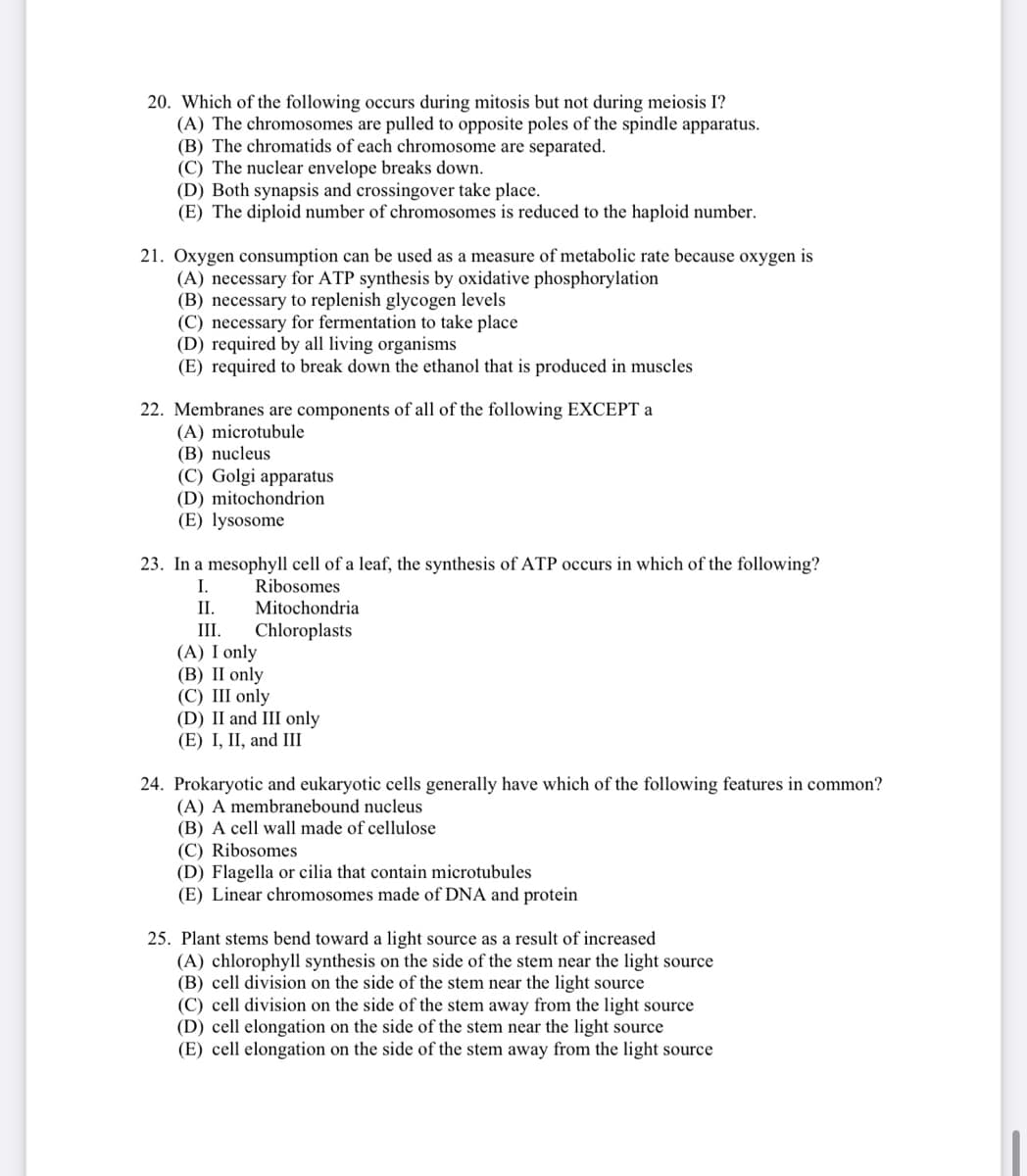20. Which of the following occurs during mitosis but not during meiosis I? (A) The chromosomes are pulled to opposite poles of the spindle apparatus. (B) The chromatids of each chromosome are separated. (C) The nuclear envelope breaks down. (D) Both synapsis and crossingover take place. (E) The diploid number of chromosomes is reduced to the haploid number.
20. Which of the following occurs during mitosis but not during meiosis I? (A) The chromosomes are pulled to opposite poles of the spindle apparatus. (B) The chromatids of each chromosome are separated. (C) The nuclear envelope breaks down. (D) Both synapsis and crossingover take place. (E) The diploid number of chromosomes is reduced to the haploid number.
Biology: The Dynamic Science (MindTap Course List)
4th Edition
ISBN:9781305389892
Author:Peter J. Russell, Paul E. Hertz, Beverly McMillan
Publisher:Peter J. Russell, Paul E. Hertz, Beverly McMillan
Chapter14: Dna Structure And Replication
Section: Chapter Questions
Problem 11TYK: Discuss Concepts Eukaryotic chromosomes can be labeled by exposing cells to radioactive thymidine...
Related questions
Concept explainers
Oogenesis
The formation of the ovum (mature female gamete) from undifferentiated germ cells is called oogenesis. This process takes place in the ovaries (female gonads). Oogenesis consists of three stages known as the multiplication phase, growth phase, and maturation phase.
Cell Division
Cell division involves the formation of new daughter cells from the parent cells. It is a part of the cell cycle that takes place in both prokaryotic and eukaryotic organisms. Cell division is required for three main reasons:
Question

Transcribed Image Text:20. Which of the following occurs during mitosis but not during meiosis I?
(A) The chromosomes are pulled to opposite poles of the spindle apparatus.
(B) The chromatids of each chromosome are separated.
(C) The nuclear envelope breaks down.
(D) Both synapsis and crossingover take place.
(E) The diploid number of chromosomes is reduced to the haploid number.
21. Oxygen consumption can be used as a measure of metabolic rate because oxygen is
(A) necessary for ATP synthesis by oxidative phosphorylation
(B) necessary to replenish glycogen levels
(C) necessary for fermentation to take place
(D) required by all living organisms
(E) required to break down the ethanol that is produced in muscles
22. Membranes are components of all of the following EXCEPT a
(A) microtubule
(В) nu
(C) Golgi apparatus
(D) mitochondrion
(E) lysosome
23. In a mesophyll cell of a leaf, the synthesis of ATP occurs in which of the following?
I.
Ribosomes
II.
Mitochondria
III.
Chloroplasts
(A) I only
(В) II only
(C) III only
(D) II and III only
(E) І, II, and Ш
24. Prokaryotic and eukaryotic cells generally have which of the following features in common?
(A) A membranebound nucleus
(B) A cell wall made of cellulose
(C) Ribosomes
(D) Flagella or cilia that contain microtubules
(E) Linear chromosomes made of DNA and protein
25. Plant stems bend toward a light source as a result of increased
(A) chlorophyll synthesis on the side of the stem near the light source
(B) cell division on the side of the stem near the light source
(C) cell division on the side of the stem away from the light source
(D) cell elongation on the side of the stem near the light source
(E) cell elongation on the side of the stem away from the light source
Expert Solution
This question has been solved!
Explore an expertly crafted, step-by-step solution for a thorough understanding of key concepts.
This is a popular solution!
Trending now
This is a popular solution!
Step by step
Solved in 2 steps

Knowledge Booster
Learn more about
Need a deep-dive on the concept behind this application? Look no further. Learn more about this topic, biology and related others by exploring similar questions and additional content below.Recommended textbooks for you

Biology: The Dynamic Science (MindTap Course List)
Biology
ISBN:
9781305389892
Author:
Peter J. Russell, Paul E. Hertz, Beverly McMillan
Publisher:
Cengage Learning

Biology 2e
Biology
ISBN:
9781947172517
Author:
Matthew Douglas, Jung Choi, Mary Ann Clark
Publisher:
OpenStax

Concepts of Biology
Biology
ISBN:
9781938168116
Author:
Samantha Fowler, Rebecca Roush, James Wise
Publisher:
OpenStax College

Biology: The Dynamic Science (MindTap Course List)
Biology
ISBN:
9781305389892
Author:
Peter J. Russell, Paul E. Hertz, Beverly McMillan
Publisher:
Cengage Learning

Biology 2e
Biology
ISBN:
9781947172517
Author:
Matthew Douglas, Jung Choi, Mary Ann Clark
Publisher:
OpenStax

Concepts of Biology
Biology
ISBN:
9781938168116
Author:
Samantha Fowler, Rebecca Roush, James Wise
Publisher:
OpenStax College

Biology (MindTap Course List)
Biology
ISBN:
9781337392938
Author:
Eldra Solomon, Charles Martin, Diana W. Martin, Linda R. Berg
Publisher:
Cengage Learning